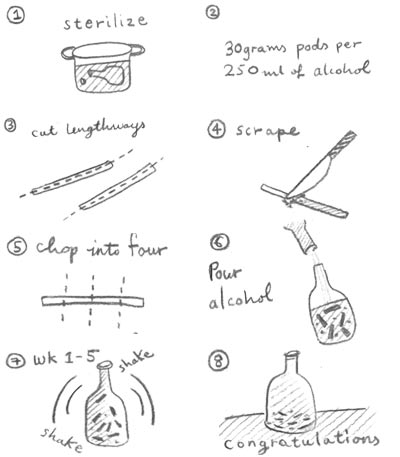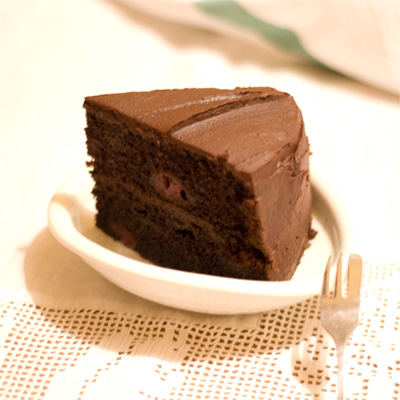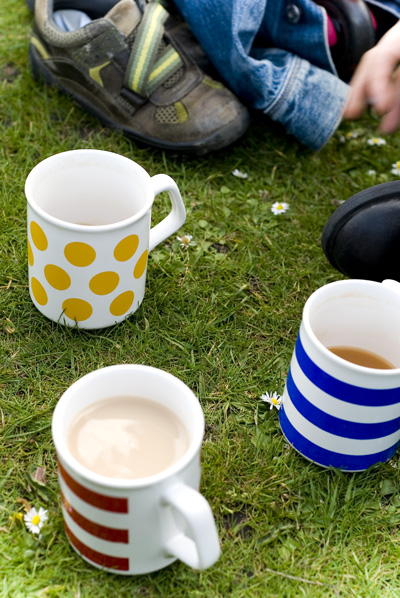Stupendously easy homemade butter & fun buttermilk pancake
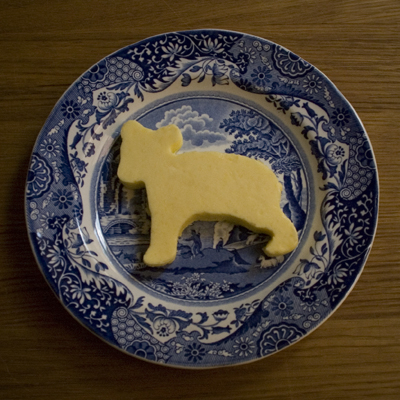 (Bear cub – Homemade butter cut out with cookie cutter.)
(Bear cub – Homemade butter cut out with cookie cutter.)
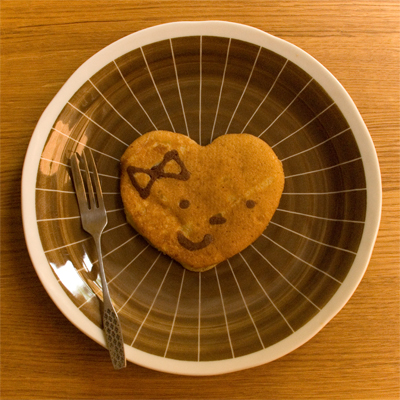 (Heart shape buttermilk pancake)
(Heart shape buttermilk pancake)
.
About time for some recipes from yours truly. xx
.
First, I would like to write about how easy it is to make butter in your very own home. Not just any butter, but a deliciously creamy one, quite unlike any that you’ve had before, I promise. And all from JUST one ingredient; double cream (& salt to taste), which you JUST over-whip until the liquid has separated & leaves you with the semi-solid, which is the butter (more precisely, butterfat). Stupendously easy right? Told you!! ^^
.
And here’s the revelation. The left over liquid is, guess what? Buttermilk!!!! So don’t throw it away because we are using it for our pancakes later.
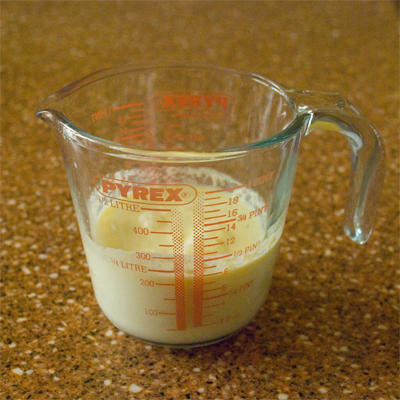 (Buttermilk extracted from double cream!!)
(Buttermilk extracted from double cream!!)
.
Here’s what you’ll need to make butter:
- Double cream
- Mixing bowl & hand-mixer (or Food processor)
- Salt (try adding 0.5% of total butter to start with, & add more if you prefer)
.
And to make it:
- 1. Start whisking the double cream in a deep-walled mixing bowl. (… deep walled bowl is better as the liquid will spit like mad!)
- 2. At first it will look like chantilly cream you’d use for cake decorating. Continue whisking.
- 3. A while later it’ll start to curdle (looking like cottage cheese). Soon after, it will start oozing liquid.
- 4. Whisk until it has broken in to two components, solid & liquid. The solid is very fresh butter & liquid, buttermilk.
- 5. Collect the buttermilk for later use. Then whip the butter more to extract as much liquid.
- 6. Weigh how heavy your lump of butter is, and calculate how much salt you’d like to incorporate.
- 7. Vigorously work in the salt to the butter to ensure even distribution.
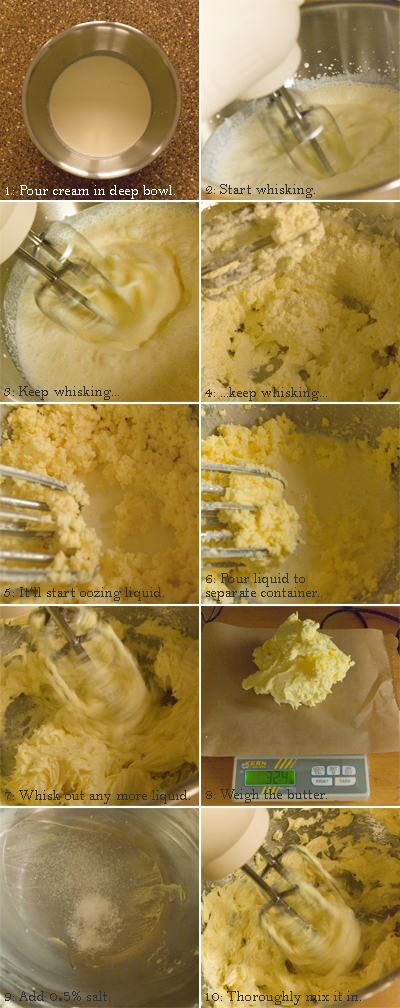
To store, you can just scoop it in a Tupperware & refrigerate, or, if you like, you can roll it to 1.5cm thickness or more in-between greaseproof paper like the picture below, then freeze it for a while (1-2 hours) to make it hard to cut shapes using cookie cutters!!! (… it is best to use simple shapes that don’t have intricate corners. Also, you might want to use a cooks’ blow torch to ease them out of the mold.)
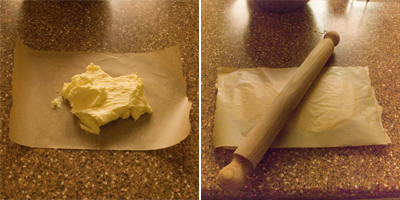
Guide notes:
- The double cream has to be fresh, not UHT or vegetable oil substitute.
- Some recipes will say to ‘wash the butter’ at the end. It is done to wash out any residual buttermilk so that the butter keeps for longer. I have skipped this step because it’s an extra work that takes the fun away, but please feel free to do so.
- Make sure to salt the butter AFTER you have collected the buttermilk. You wouldn’t want to flavour the buttermilk right?
- Butter yield: From 600ml of double cream, I ended up with 324g of butter & 235ml of buttermilk.
- This butter has a ‘cleaner’ note to the taste than shop-bought ones. And perhaps less yellow.
- The science: Cream contains tiny globules of butterfat surrounded by membranes. By agitating the cream by whipping, the membranes of these globules break & the loosened butterfat chain together to form a solid mass = butter. For more information, please check out this website.
.
x . . . x . . . x . . . x . . . x . . . x . . . x . . . x . . . x . . . x . . . x . . . x
.
Next, let’s make some fun looking pancakes!
In the recipe below, I have used silicone egg rings to make shapely pancakes. And also had some fun drawing on them. Ofcourse, you can approach this the usual/ easier/ quicker way by just freehand scooping & pouring! – And as for the recipe itself, it produces very moist pancakes that is very (very) moreish, I can assure you it’ll disappear from your plate in nooooo time… Ever since I made this recipe, we always have buttermilk in our fridge for a quick fix up!
.
x . . . x . . . x . . . x . . . x . . . x . . . x . . . x . . . x . . . x . . . x . . . x
.
Buttermilk pancake recipe:
.
Ingredients:
- Plain flour… 120g
- Sugar… 40g
- Baking powder… 5g
- Baking soda… 3g
- Egg… 1
- Buttermilk… 200ml
- Vanilla extract… a dash
- Melted salted butter… 40g
- Cocoa powder… roughly a teaspoon
You’ll need the following things:
- Mixing bowl
- Silicone egg rings
- See-through lid that covers your frying pan
- Optional: Maple syrup or icing sugar to serve
.
Method:
- 1. First we prepare two separate bowls of ingredients;
– – a: sifted dry ingredients: flour, baking powder & baking soda.
– – b: mixed wet ingredients: egg, buttermilk, vanilla extract, but minus the melted salted butter which we will incorporate in step 3. - 2. Make a well in the middle of the dry ingredients & GRADUALLY pour in the wet ingredients, whisking all the time.
- 3. When you have whisked the batter until it is not clumpy, pour in the melted butter & whisk it in.
- 4. Next, pour some of the mixture in another small bowl, then add cocoa powder to colour it brown.
- 5. Put the cocoa batter in a piping bag.
- 6. Heat the pan on low.
- 7. Grease the pan thinly with melted salted butter. (…using folded kitchen paper to smear it across is my choice of method.)
- 8. Place the silicone egg ring on the pan.
- 9. Pipe a simple design quickly using your cocoa batter.
- 10. When the cocoa design has dried, pour the pancake batter in the egg-ring (…here, make sure it is just under half the height of your mold, as anything higher, the batter will flood out when frying).
- 11. Place the lid on (…a glass lid would be best so that you can keep an eye on how the pancakes are doing).
- 12. Wait until you start to see bubbles appear on the surface & the edges slightly cooked.
- 13. Flip the pancake with the egg-ring still attached (…I find that flipping together with the mold ‘spill-free’).
- 14. Fry until it browns (about under a minute).

Guide notes:
- This recipe does not work with milk as substitute for buttermilk. I tried & it came out edible, but not nearly as tasty as the proper buttermilk version. – I also did a test-run with milk that has been soured with lemon. It was much better than the ‘milk-only’ version, but nothing beats the real thing.
- If you are using the silicone mold straight again, just give it a quick wipe with the kitchen towel to get rid of any residue.
- Use the batter straight away. Never rest it. The reason for this has to do with the two leavening agents in this recipe:
– Baking powder reacts to moisture & enlarges the carbon dioxide (air) within the batter. It expands upwards.
– As for the baking soda, which expands sideways, primarily reacts with acidic components (such as buttermilk) to give off carbon dioxide that expand under temperature. For both agents, the reaction is immediate after being incorporated, so please don’t rest the batter or the carbon dioxide will start to dissipate, & it won’t rise so well.
– Another point worth mentioning about these leavening agents is that you should not use aged stuff that’s been lying around in your store cupboard, as it won’t be as reactive, it’ll have a bitter taste, & you’d get a disappointing result. - I like using salted butter for this recipe. Salt is known for enhancing the flavours of the other ingredients, especially sweetness. I also like to grease the pan with the salted butter.
- Silicone molds are the best. I tried metallic shapes such as standard cookie cutters, greasing the sides with butter then flouring, but the pancake sticks now & again & it does not give you consistent results. Also, complicated shapes should be avoided as they are finickity.
.
Some more designs:
.
This one is an evolving message on a pancake as they eat! The surprise is right at the bottom!
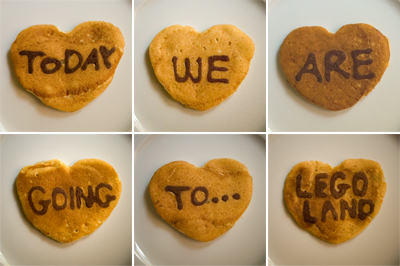
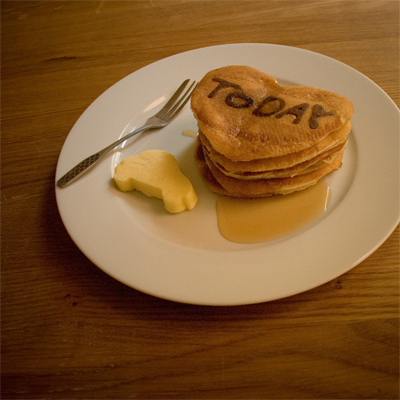 (… With car-shaped butter!) You have to pipe the letters mirrored – which can get confusing!! (notice the ‘Y’ in ‘today’?)
(… With car-shaped butter!) You have to pipe the letters mirrored – which can get confusing!! (notice the ‘Y’ in ‘today’?)
.
And there’s the three bears: .
.
This one, I used my stencil to dust a bit of icing.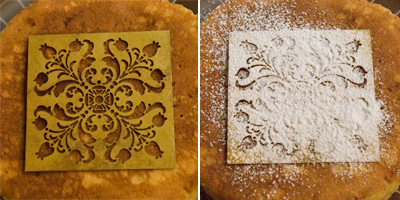
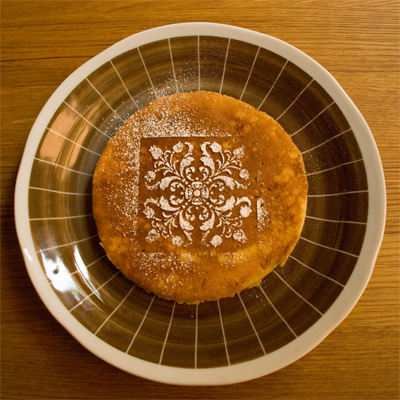 .
.
More playing around…
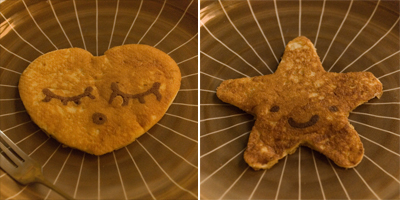 .
.
And finally, a picture of a squirrel butter, which ends my longest ever recipe post!!!!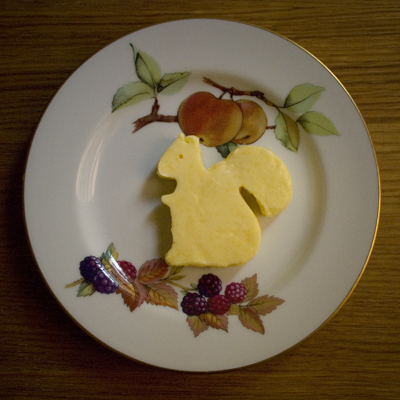


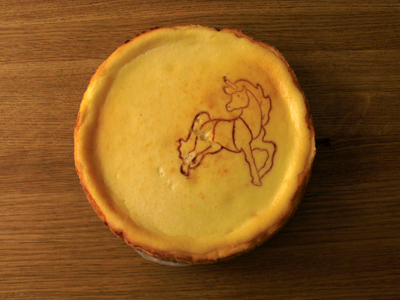 (…with unicorn pattern embossed)
(…with unicorn pattern embossed)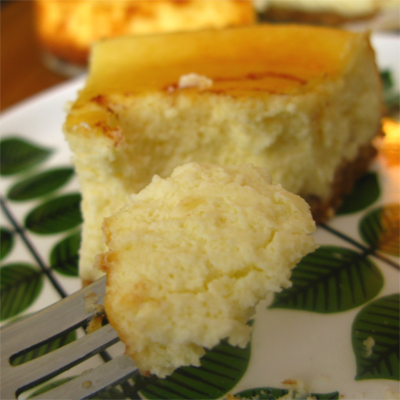 (It is ultra c
(It is ultra c 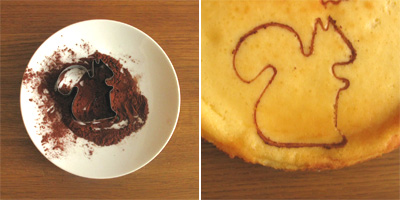 (I get asked A LOT at the market on how I do it!)
(I get asked A LOT at the market on how I do it!)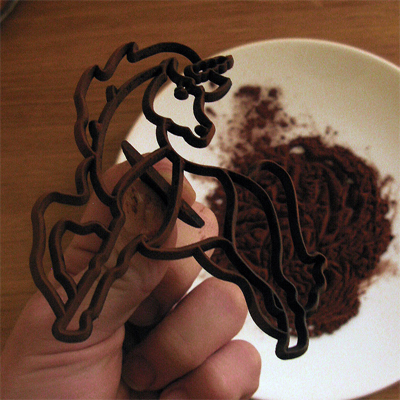 (My favorite stamp! – I love unicorns…)
(My favorite stamp! – I love unicorns…)
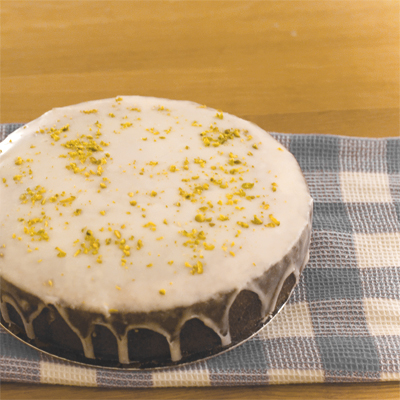

 (I made three bottles – with vodka, brandy & rum to experiment. In 5 weeks time I’ll know which one came out best!)
(I made three bottles – with vodka, brandy & rum to experiment. In 5 weeks time I’ll know which one came out best!)
